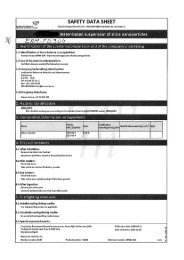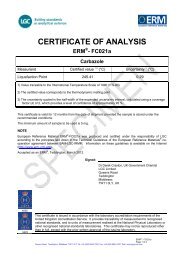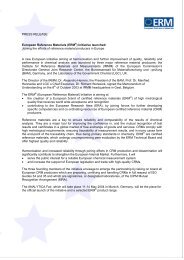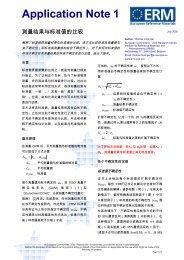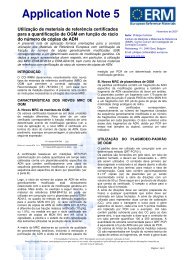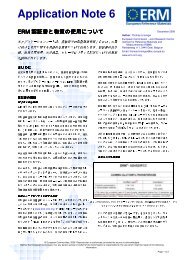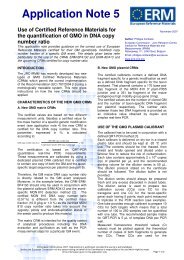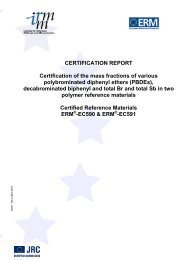Certification Report Certified Reference Material ERM - European ...
Certification Report Certified Reference Material ERM - European ...
Certification Report Certified Reference Material ERM - European ...
You also want an ePaper? Increase the reach of your titles
YUMPU automatically turns print PDFs into web optimized ePapers that Google loves.
accordance with [3] was then calculated by quadratic averaging of the resp. relative<br />
laboratory estimators. Table 3 shows the resp. estimators for inhomogeneity.<br />
Since most of the data for inhomogeneity estimation were produced on the basis of a sample<br />
intake of 5 g, the minimum sample intake for the use of the certified reference material is<br />
5 g.<br />
Table 3: Estimated inhomogeneity, ubb (ubb,abs for Cu, Ni in %, for all other elements in<br />
mg/kg)<br />
Element ubb,rel ubb,abs<br />
Cu 0.27 % 0.0406<br />
Ni 0.47 % 0.00221<br />
In 2.32 % 2.11<br />
Ag 0.76 % 5.25<br />
Au 0.43 % 1.26<br />
Pd 0.88 % 0.797<br />
Pt 3.60 % 0.307<br />
Be 0.78 % 0.537<br />
5. Stability<br />
There is no instability of the certified material to be expected (calcinated inorganic material) if<br />
the material is stored at ambient temperature. To be sure that no oxidation of the matrix<br />
appears, the mass of three individual bottles will be checked regularily every six month. An<br />
expiry date of 10 years is given.<br />
6. <strong>Certification</strong> study<br />
6.1 Analytical methods<br />
19 laboratories participated in the certification interlaboratory comparison. Each laboratory<br />
received one randomly chosen bottle with approx. 200 g of powder. Before analysis the<br />
material had to be dried at 105 °C for at least 8 hours.<br />
The laboratories were told to analyse six subsamples. They were free to choose any suitable<br />
analytical method for analysis. Tables 5 to 12 show the analytical methods used by the<br />
participating laboratories. It is noticeable that often the sample intake is below 5 g, the<br />
sample intake used for homogeneity testing. The spread of single results from laboratories<br />
using less than 5 g for analysis gave no hint that the material was not homogeneous (n.a.<br />
means not available).<br />
For all analytical methods where a calibration was necessary this calibration was performed<br />
using liquid standard solutions. All participating laboratories were asked to use only standard<br />
solutions prepared from pure metals or stoichiometric compounds or well checked<br />
commercial calibration solutions.<br />
9



